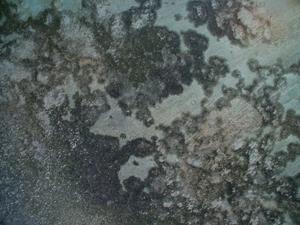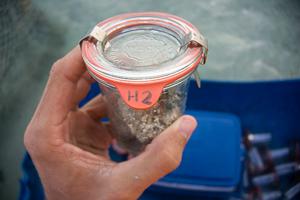Steven Lee
This project aims to characterize the ecological role of Holothuria scabra (Sandfish) and the sedimentary effect of their over-harvest. We will also investigate the variability of sea cucumber population structure and diversity over tidal cycles, daily cycles, and microhabitats.

Aerial of the site, if you look closely you can see some of the enclosures.
Sea cucumber fisheries provide a critical source of income to many Pacific Island coastal communities through the bêche-de-mer trade. Heavy demand and high prices from Asian markets have driven the growth of sea cucumber fisheries. Consequently, this has led to many species being heavily exploited throughout the Pacific for many decades. Sea cucumbers reduce algal and microphytobenthos biomass, thus inhibiting algal blooms and decreasing organic matter content on sediment. Recent studies also suggest that sea cucumbers play a substantial role in structuring bacterial communities at the sediment-seawater interface. Therefore, we postulate that a reduced sea cucumber density likely has significant negative effects on coastal ecosystems, which could ultimately interfere with critical ecosystem services that Pacific Island coastal communities rely on.

Sediment cores for porosity and grain size analysis.
This project aims to characterize the ecological role of Holothuria scabra, by investigating the effect different densities of H. scabra have on key sedimentary characteristics and processes. H. scabra is among the highest value tropical species in the bêche-de-mer trade and is one of the few sea cucumbers that are successfully farmed, therefore has the potential to provide a sustainable source of income to Pacific Island communities.
The project will be based in Natuvu village, Vanua Levu, Fiji. In situ enclosures will mimic different densities including removal to simulate intense harvesting, and high densities to simulate farming. The results will improve our understanding of the environmental impact of the continued harvest of Holothurians and intense sea cucumber mariculture.
Surveys will investigate the variability of sea cucumber population structure and diversity over tidal cycles, daily cycles, and microhabitats. This will help to improve sea cucumber survey methods in the region, and provide further information on their ecology.
We expect that our results will provide the first tangible information on the ecosystem role of these key organisms in Fiji, thus providing the basis for science-based conservation of these animals. All results will be shared and discussed with local communities, NGOs, and the Fiji Governmental Fisheries Department, which is currently drafting regulations of the sea cucumber fishery.